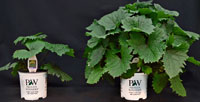4/25/2013
Ligularia Bottle Rocket: Out-of-This-World Shade Perennial
Jeremy Windemuller

A refined version of the original, Ligularia Bottle Rocket grows into a densely compact clump of very large, thicker leaves that stand up to the summer heat. A bouquet of yellow flower spikes is held just at the top of the foliage with no naked stems showing in midsummer.
Pictured: Ligularia Bottle Rocket benefits greatly from being planted the year before it’s sold. Those potted in fall for sales the following spring (right) are much fuller with larger leaves and more flowers per plant than those potted up and sold the same spring (left). If you have the facilities to overwinter potted perennials, we recommend that you start this plant the fall before you plan to sell it.
Spring planting guidelines
To finish Bottle Rocket in smaller trade 1-gal. pots, use a 72-ct plug and allow 8 to 10 weeks for finishing. 20-ct plugs should take the same amount of time to finish in larger premium 1-gal. containers. If planting in early summer for sales the following spring, start with a 72-ct plug in a premium 1-gal. container.
When growing Bottle Rocket in spring, fertilize plants with a constant liquid feed of 75 to 100 ppm Nitrogen. Maintain a pH of 5.8 to 6.2 and an EC of 1.5 to 2.5 using the pour-through method.
Early fall planting guidelines
Purchase Bottle Rocket plugs as early in fall as possible, especially in northern climates. This plant needs to be well-rooted before going into dormancy. Use one 20-ct plug per premium 1-gal. or 2-gal. pot to finish for the following spring’s sales.
Maintain the same EC and fertilizer rates as in spring plantings until fall arrives and night temperatures fall below 50F (10C). Back off the fertilizer once the plants begin to shut down for winter.
Cultural recommendations
Moisture: Maintaining consistent moisture levels throughout the growing season is absolutely critical for ligularia. Don’t let these plants dry out! It’s good practice to water in the morning and allow the foliage to dry off before nightfall to avoid potential disease issues.
Lighting: Ligularia requires long days to induce flowering. It’s naturally adapted to perform best in partial shade. In the greenhouse, provide 30% shade in the north and 55% shade in the south. There’s no need to provide supplemental lighting unless you’re forcing the plants into bloom (see Forcing below).
Temperature: Bottle Rocket roots out best in temperatures of 60 to 68F (15 to 20C). Once the plants are rooted out, a minimum holding temperature of 50F (10C) is sufficient.
Pests and Diseases: It’s good practice to apply a broad-spectrum fungicide drench on plug material at time of transplant to prevent root and crown rot. However, Bottle Rocket has shown good resistance to root and crown rot compared to older varieties. Scout regularly for aphids and thrips, treating as necessary.
Finishing tips
General Finishing Guidelines: Bottle Rocket is naturally compact and doesn’t require pinching or PGRs to maintain its dense habit. This is a large, widely mounding perennial with sizable leaves. Be sure to space plants well to allow the leaves to unfold naturally and form a well-rounded, full plant. Well-grown plants are typically 2 to 3 times wider than the container, so they may need to be re-spaced several times during the growing cycle.
Finishing Larger Specimen Plants: An impressive specimen of Bottle Rocket can yield high margins for growers. To finish in premium 2-gal. containers, start with a 20-ct plug in early fall of the year prior. No stepping up is required; simply plant the plug right into the large container.
Root the plants out outdoors under 30% shade in the north or 55% shade in the south. Fertilize with a constant liquid feed of 75 to 100 ppm Nitrogen until nighttime temperatures fall below 50F (10C), and then bring them indoors to finish the rooting process. Be sure to maintain consistent moisture levels throughout production, but let plants dry slightly between waterings when dormant.
When spring arrives, grow these plants warm at 68 to 78F (20 to 25C) and allow 6 weeks for the foliage to fully develop. To have plants in flower for spring sales, allow 10 to 12 weeks from the time they emerge.
Forcing: Bottle Rocket is a cold obligate perennial. It will not flower if it’s not vernalized properly. If you receive your liners in late winter or early spring, they should already have been vernalized by your supplier. If receiving them in summer or fall, you will need to vernalize them for 8 to 12 weeks at 40F (4C) or lower in order to have flowers. Once vernalized, they should bloom in 10 to 12 weeks under 68 to 72F (20 to 22C) constant temperatures. Supplemental lighting will be necessary to get this plant to bloom for spring sales as it’s long-day obligate, meaning it requires 16-hour days to induce flowering.
GT
Ligularia Bottle Rocket PPAF is a Proven Winners Perennial. A branded container is required for this plant.
Jeremy Windemuller is a grower and trial manager for Walters Gardens, Inc. in Zeeland, Michigan.